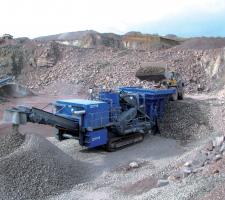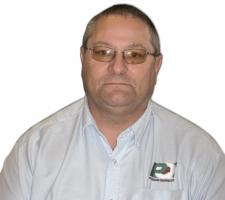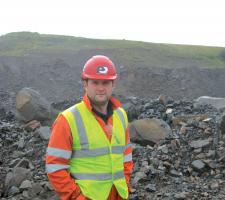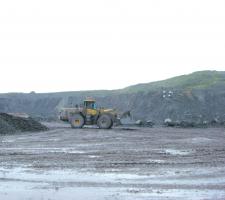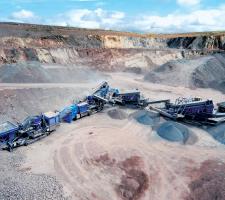
When the time came to change its old static crushing plant, one Scottish quarry decided to go mobile and bought an entirely new system. Patrick Smith reports
Rusting chunks of metal ready to be sold or recycled are all that is left of the old stationary crushing plant that once served a Scottish quarry. Set on top of a small hill in a barren landscape just a few miles from Glasgow, the Dunduff Quarry, 2.5km south-west of Kirkmuirhill in the south of County Lanarkshire, is in a state of change.
Gone is the old Svedala crushing system to be replaced by a modern 'single size system' from
Patersons of Greenoakhill Limited, with its headquarters in Coatbridge, near Glasgow, now operates six quarries in west and central Scotland, including Greenoakhill together with Beltmoss Quarry, Kilsyth; Cowiehall Quarry, Stirling; Floak Quarry, Newton Mearns; Nether Murhat Quarry at Beatock, and Dunduff Quarry.
Greenoakhill Quarry was first granted a licence in the early 1950s with sand and gravels extracted to form what today is Greenoakhill landfill site.
Dunduff Quarry was the company's second operation and work started in 1980 to extract the hard rock, which is crushed and graded to give the quality assured aggregate materials used extensively in the construction industry.
Over the last three decades Patersons Quarries has expanded to become one of the largest independent quarry operators in UK with a turnover in excess of £60million (€68million), and has diversified into several complementary businesses that provide a wide range of solutions and products to the construction industry and beyond. These range from concrete block manufacture to waste management and engineering as well as landfill, silica sand, hard rock and sand and gravel.
Major investment
Its latest venture at Dunduff Quarry represents a major investment on behalf of the company, which is planning to expand the site to gain more material.
Phil Doherty, quarry manager, said, "It is a hard rock quarry and we sub-contract the blasting for the primary crusher and we do various fractions which we reprocess using the aggregate plant, which among other things obtains materials for all the concrete requirements of the company. We have our own concrete plants in the company for making blocks.
"In the past, we have produced up to 1.25million tonnes of material a year but now we have been doing about 750,000tonnes over the last nine months as demand has dropped. We do single sizes and blended mixes for various applications, including road jobs, as required by our customers." The existing quarry, which covers 62ha, has a life of about 20 years, but with the extension (the size is undecided) this will add an extra 10 years.
"This is so that we can get more material and also to improve the egress of the quarry so it is less of an impact to the local village. We are very proactive with the community, and have lots of meetings with local people to discuss our plans," said Doherty.
"The reason for putting the new plant in was to replace the old static plant.
Having looked at this we decided to follow the trend and looked at mobile plant.
"We chose Kleemann products for several reasons. For one, our experience with Kleemann plants in the past has been very positive. We also know that the company has a profound process knowledge gained in several decades of experience in stationary plant construction, which they have often successfully transferred to mobile projects. Therefore, we were sure that we would achieve precisely those results we were looking for." Another man who knows the quarry well is Hamilton Rankine, sales manager, Kleemann Mineral Technologies Division of Wirtgen, which supplied much of the equipment at Dunduff.
Kleemann, which has its UK head offices in Lincoln, eastern England, was acquired by the
A regular caller at Dunduff Quarry, among Rankine's latest contracts was the one to supply the completely new system to the quarry, which he is eager to explain.
Driving from the main site office down towards the quarry, various size and coloured aggregates have been stockpiled at the top: normally they would be taken straight out of the site in trucks, but the current climate means the demand is not always there. Indeed, a number of crushing and other machines have been brought in from other Patersons' quarries that have been "mothballed".
Dolerite
The rock found in the quarry is dolerite, originating from the Devonian period with inclusions of sandstone that has hardened under the influence of pressure and heat. The feldspar is of a reddish colour and is used as a decorative and high-quality product on roads, car parks, driveways and in gardens. In addition, aggregate for concrete blocks as well as coarse-grained material for concrete and frost protection are also mined in Dunduff Quarry.
"You can get almost any colour of stone here that you want: pink, black, grey, green, red. It is really very high quality material," said Rankine.
Near the stockpiles is the old stationary machinery (some has already been sold), and this is an area where further blasting is likely to open up a new section of the quarry next to the existing workings and where a strict one-way haul road system spirals down to the floor where the new single size system is the centrepiece. Climbing back out of the quarry, vehicles drive out through the weighbridge.
Health and safety are paramount at the site, with Phil Doherty, among others, regularly ensuring that accesses, walkways and guards are in proper order.
Indeed, among the safety features are an electrical lock-out unit for the control cabinets and a ground re-fuelling system.
"Dunduff was a static quarry but it has gone from the drill, blast, haul and static crusher to all mobile impact crusher, primary crusher, secondary crusher, tertiary crusher and screening.
"Big dump trucks used to take blasted rock to the static plant and this is very heavy on tyres and fuel and is not a very efficient way to transfer material. The new system has removed a lot of the plant that used to be in the quarry and thus reduced operating costs," said Rankine.
During the busy times blasting took place three times a fortnight and the rock gained varied from 15,000 to 45,000tonnes depending on how the bench was developed.
"Patersons has shown great brand loyalty to Kleemann," said Rankine. "It first bought a crusher and screen working in tandem that was supplied in 2005, and then the company ordered a large jaw crusher and screen for another quarry, and then ordered the big jaw crusher followed by this new single size system for Dunduff.
"We also hold a lot of spare parts at Dunduff Quarry. These are kept in a special container, which is filled with parts. It is a big benefit for Patersons, and of course for us as we own the stock and parts can also be used elsewhere on other Kleemann machinery.
"This is a very good working relationship. We also have an inspection contract on all the machines at Dunduff.
We go in quarterly and check the machines and do a report on them." On a rock bench near the top of the quarry, where rock has been removed, the primary jaw crusher, a Kleemann Mobicat MC 125 Z (one of two primary crushers), is crushing material. The 125tonne unit on tracks has a 1,250mm x 1,000mm jaw, and the diesel electric-powered machine is said to be good on fuel consumption.
Another safety feature at the quarry is a pecker for the crusher to ensure that any blockage can be cleared from a safe distance via a radio remote-control system. The crusher is being fed by a
Among other equipment are two Komatsu WA470 wheel loaders that work down at the bottom of the quarry; a Komatsu WA500 wheel loader for general duties and for taking material away from the primary crushing operation, along with a 35tonne
He explains that the screener on the quarry top primary system is operated by the jaw crusher generator set so there are further savings on fuel and servicing of the screen.
"They are connected so that they 'speak' to each other by an interlink," said Rankine. "The screen, a Kleemann Mobiscreen MS 182 AD, was bought in 2005, and is a direct feed screen that weighs about 36tonnes. It is 5m long and 1.8m wide with two decks and what is known as a three-way split. Here they make three different products from the primary crushed material: a minus 50mm material which can be blended with Type 1 [a graded aggregate containing crushed fragments of rock between 75mm or 50mm down to dust and every size between] or general civils or spread further into single sizes. Then there is the 50-100mm (most of this will be recrushed unless it is used for pipe work) and then oversize of 100-200mm, most of which will be recrushed. Depending on the material this crusher can handle up to 600tonnes/hour." Special features on the jaw crusher include on the feeding system a vibrating pan feeder and then a separate doubledeck independent pre-screen that separates far more fines from the crusher which results in higher efficiency.
Another feature is that under the jaw the material falls into the vibrating pan feeder. On most conventional crushers it would fall onto the belt.
The second primary crusher about half way down the quarry road is a Mobicat MC 120 Z, which was also bought in 2005. It weighs 75tonnes and is on tracks with a 1,200mm x 800mm crusher.
The crusher also has an independent pre-screen before the crusher and the vibrating pan feeder in the crusher.
Its job is to crush tough blasted rock and produce minus 200mm material which goes to the ground. This follows the blast and crushes to the ground where material is picked up by a shovel, probably the WA 470 and feeds the mobile single size system. That feed is supplemented from the oversize from the big primary crusher on top of the quarry.
At the configuration for the fully mobile single size system, the secondary cone crusher, a Mobicone MC0 11, weighing about 60tonnes, is diesel electric powered and is equipped with a
"This will take the primary crushed material (-200mm) as well as any oversize you may want to feed it and then crush it to about 60-65mm," said Rankine.
"The next machine in line, the Mobicone MC0 11 S, is not so basic. This is a cone and screen combination on one set of tracks. There are different configurations for this machine but it is designed so that the screen will de-dust before the tertiary crusher. It weighs about 70tonnes and it also has the HP300 cone and is again diesel electric powered." Material goes into the surge hopper and drops into the pan feeder and then into the feed belt (minus 60-65mm) and onto the two-deck screen. De-dusting takes away the small particles or fines.
The dust goes onto the main belt and is joined by crushed material which at this point would be minus 40mm material, although of this the vast majority would be minus 20mm.
It goes into the first screen, the Mobiscreen MS 17 Z, the two-deck screen, which is 5m long and 1.8m wide.
"The 40mm material can either be dropped to the ground as a product or recirculated back around via the recirculation conveyor into the tertiary cone crusher, the MC0 11 S. On the other side of the MS 17Z, 20mm finished single size material is produced," explained Rankine.
"The final screen is a Mobiscreen MS 20 D (6m x 2m), which is the three-deck banana screen. Rather than the deck being straight, it curves towards the bottom thereby slowing down the material and increasing the efficiency of the end screening.
"This does the final single size screening and it drops on the ground 14mm, 10mm, 6mm, and dust. It separates and stockpiles a total quantity of more than 150tonnes/hour of material into high quality final aggregate fractions of grain sizes 10-14 mm, 6-10mm, 3-6mm and 0-3mm.
"The beauty of this system is if there is a problem with one of the machines, and that is not often, you can take it out of the line and still produce some of the materials.
"On this system everything is controlled automatically and is interlinked. There are not many companies with single size systems in the UK. The single size system is a 200tonnes/hr system for feeding."


